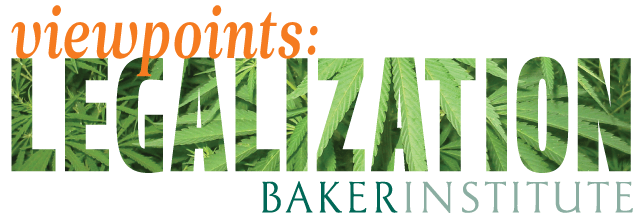
Baker Institute Viewpoints is a regular blog series that presents an array of views on a single issue. In this installment, four Baker Institute fellows and three guest experts considered whether the United States should legalize marijuana. Each weekday since Sept. 17, one of the seven writers — whose backgrounds include a biography of evangelist Billy Graham and a 30-year career in the Drug Enforcement Administration — gave his or her take on the issue. Today, in the final post of the series, guest writer Kevin A. Sabet, Ph.D., director of the Drug Policy Institute at the University of Florida College of Medicine, discusses the “fundamental disconnect between what research tells us about marijuana, on the one hand, and relaxed public attitudes toward the drug, on the other.”
Read the previous posts in this series:
- “Marijuana: A case for legalization,” by William Martin, director of the Baker Institute Drug Policy Program.
- “In a contest with alcohol and tobacco, marijuana wins,” by guest writer Sylvia Longmire, an author and expert on Mexico’s drug wars.
- “Legalization of marijuana: When, not if,” by Baker Institute nonresident drug fellow Gary Hale, former chief of intelligence in the Houston Field Division of the Drug Enforcement Administration.
- “Regulations work: Lessons from California’s experience with medical marijuana,” by guest writer Tom Heddleston, Ph.D., whose dissertation examined the formation and development of the medical marijuana movement in California.
- “Marijuana won’t be legalized anytime soon,” by Tony Payan, visiting Baker Institute Scholar for Immigration and Border Studies.
- “Why legalizing marijuana is a bad idea,” by Joan Neuhaus Schaan, fellow in homeland security and terrorism at the Baker Institute.
The most popular of all illicit drugs is the subject of countless urban legends. And it’s important to keep in mind that urban legends about marijuana find their origins on both sides of the ideological spectrum. During most of the 20th century, much of the mythmaking involved hysterical attempts to demonize pot and its users. The notorious 1936 movie Reefer Madness – which was a Hollywood production, not a government propaganda film – is one such example. When marijuana became a staple of the 1960s counter-culture, mainstream conservative elements of society reacted to the “devil weed” with an attitude of “put all the users in jail and throw away the key.” There is also no doubt that some of our nation’s first anti-drug laws were motivated by fear and racism, as David Musto has highlighted.
Fast-forward to today and much of the mythmaking and exaggeration comes from a powerful lobby whose aim is to legalize marijuana. Capitalizing on the unfounded myths and hysteria of the past, pro-marijuana campaigners conveniently ignore the fact that today’s marijuana hardly resembles that of the 1960s. (Producers of the drug have learned to increase the psychoactivity of the marijuana with a much higher concentration of THC.) Supporters of legalization laud marijuana for its harmlessness, its revenue-generating potential and its medical wonders. These claims deserve closer scrutiny.
Is marijuana harmless?
Science has learned more about marijuana in the past20 years than in the preceding 200. Ironically, however, there has been a major incongruence between the scientific knowledge gained and the public’s understanding of the drug. People often refer to their own experiences with marijuana rather than what scientific data has taught us. Here are some fast facts about marijuana’s health hazards:
- Most people who use marijuana will stop after trying it once or twice. And most of the rest will not become addicted and not use other drugs. This, however, is the case with most drugs — not just marijuana.
- 1 in 10 people who try marijuana will become addicted to it, developing a dependence that produces withdrawal, cravings, etc. If marijuana use starts in adolescence, the chances of addiction are 1 in 6.
- Marijuana is linked to poor learning outcomes, including a significant reduction in IQ, cardiovascular issues and respiratory problems (not to the extent of tobacco smoke, though marijuana contains more tar and carcinogens than tobacco). Driving while high on marijuana doubles the risk of a car crash. Marijuana use also significantly increases the risk of acquiring a mental illness.
Marijuana and Economics
Research uniformly reveals that under legalization, the price of drugs would fall substantially, and use would increase. Any tax revenue gained from legal marijuana would be quickly offset by the social costs resulting from this increased use: witness how today, society receives about $1 in alcohol and tobacco tax revenue for every $10 lost on the social costs of those two legal drugs. Increased drug use means increased costs.
Furthermore, there is no guarantee that marijuana legalization would significantly diminish the underground market for marijuana. In a legal market, where marijuana is taxed, the well-established illegal drug trade has every incentive to remain. Today’s thriving underground market for tobacco is a good example of this. The drug trade is so profitable that even undercutting the legal (taxed) market price would leave cartels with a handsome profit. Marijuana legalization would also do nothing to loosen the cartels’ grip on other illegal trades such human trafficking, kidnapping, extortion, piracy and other illicit drugs.
What about criminal justice costs? Shouldn’t they go down if marijuana is made legal? The case of alcohol again provides an illuminating example. Surprisingly, (legal) alcohol leads to more arrests every year than do all illegal drugs combined. Driving while drunk, liquor law violation, and public drunkenness result in over 2.5 million alcohol-related arrests every year. That isn’t to say that current drug policies aren’t also costly to the criminal justice system. They are. But that is precisely why we need smarter enforcement policies — not legalization, which would very likely compound the current costs.
“Medical” Marijuana?
What about marijuana’s medical value? We know that there are components in marijuana that have medicinal value. Some of these components have been turned into a pill; others are being developed into a mouth spray. But, as the Institute of Medicine has concluded, we do not need to inhale the raw marijuana plant to benefit from the plant’s beneficial components. Just like we do not smoke or ingest opium to receive the medical benefit of morphine (which is derived from just one component in opium), we should not have to smoke or eat whole marijuana to get its beneficial medical effects.
Unfortunately, there is a fundamental disconnect between what research tells us about marijuana, on the one hand, and relaxed public attitudes toward the drug, on the other. Add to this the relentless campaign to legislate raw marijuana as medicine, or to legalize the drug outright, and we get parents and lawmakers who are confused and conflicted. All of this confusion has muddied the policy waters so thoroughly that urban legends rule the day when it comes to marijuana. It’s time to get honest, heed the science and realize that the answer to the question “What is the most effective marijuana policy?” may not be as easy as one might think.
 Kevin A. Sabet, Ph.D., is director of the Drug Policy Institute at the University of Florida, College of Medicine. He served as a drug policy senior adviser in the Obama administration from 2009-2011.
Kevin A. Sabet, Ph.D., is director of the Drug Policy Institute at the University of Florida, College of Medicine. He served as a drug policy senior adviser in the Obama administration from 2009-2011.